
RACE: The WTCC Game
Written by: Rik
Date posted: November 14, 2016
- Genre: Racing
- Developed by: SimBin
- Published by: Eidos Interactive
- Year released: 2006
- Our score: 8
‘Proper’ racing simulators have always been a little bit beyond me. Perhaps it’s because the subtleties and nuances that attract fans of real-life motor racing – pit-stop strategies, car setups, the politics of whether a particular overtaking manoeuvre was right or wrong – just aren’t of interest. Or perhaps it’s because they’re quite complicated and I tend to be a bit crap at them. But as much as I generally favour the arcade racer, experiences with some of the flimsier examples of the genre can make one crave a little more realism. In my case, it was the dubious qualities of Juiced 2: Hot Import Nights, with its weightless handling and consequence-free collisions that caused me to seek out a game in which driving fast seemed mildly dangerous, and actually felt like you were steering a weighty mass of metal.
There’s a rich history of old sims from the 90s – the big hitters being Geoff Crammond’s Formula One Grand Prix games and the IndyCar/NASCAR games from Papyrus. Occasionally, I’m tempted to give them a go, but they’re as hard now as they ever were. I eventually came to realise that when I’d played NASCAR Racing as a kid, I’d borrowed it off a friend, marvelled at the graphics and the signature introduction sequence (“I’m Ned Jarrett…from Papyrus, this is NASCAR Racing!”) before experimenting with just how much mayhem could be caused by turning my car around and racing the wrong way around the track.
Personally, I always had a soft spot for Codemasters’ TOCA Touring Cars games, and for reasons that are most probably nostalgia-based rather than rooted in any particular love of the sport, I fancied returning to that world again. Of course, the TOCA series continued into the 00s and beyond, and my experience of the Race Driver games I played was generally positive, but their focus on a variety of vehicle and race types, increased arcade leanings and additional storyline elements took them further away from simulation territory. Basically, I wanted a game where you could go through a season being as crap as you liked, without repeated failures being a barrier to progress, and the only note made of that failure a bald statement of fact: nul points for this race, Rik.
And so we come to RACE: The WTCC Game, following relatively hot on the heels of developer Simbin’s acclaimed GTR games: GTR, GT Legends and GTR 2. Aside from its focus on touring cars, reviews of RACE at the time suggested that it was slower and easier than GTR, which made me think this could be the game to deliver my TOCA fix. WTCC stands for World Touring Car Championship, which isn’t exactly the same thing as the British Touring Car Championship, although there are enough common elements – the humdrum vehicles, and a sprinkling of familiar names (Rydell, Tarquini, Menu et al) – to bring back memories of watching British Touring Car coverage on the BBC in the 90s. (I recall at some point Nigel Mansell, in what seemed to my teenage eyes to be a considerable comedown from being Formula One World Champion, being interviewed by Murray Walker about why a minor race-ending crash that involved his Ford Mondeo wasn’t his fault).
Before launching into a full championship, you can use a single event to practice and generally get used to the circuits and handling. For a bit of fun you can eschew the traditional selection of touring cars in favour of some classic ones from the 80s, a BMW Mini or (if you have the relevant expansion pack) a Caterham. There are simple pleasures to be had in simply bombing around Monza with nothing more than mastery of your vehicle and an improved lap time in mind, and for anyone raised on a diet of arcade challenges, whiling away a good few hours here comes as a refreshing change of pace.
Having done so myself, though, I feared repeating my usual experience with racing sims, namely getting very well-practised at the first race of the championship before finding that to do the same on the others was too much hard work, and experiencing diminishing returns as a result. With each race weekend involving two practice sessions, qualifying, a warmup and then two races, I rarely had the opportunity to complete more than one weekend in a session of play, but focusing on one circuit at once seemed to work out well. Others may possibly have greater capacity for maintaining concentration over a longer period of time, but even having completed the championship a couple of times, I can’t imagine breezing through a number of races with any great degree of success, even with a free couple of days to devote to it.
The difficulty and realism levels can be tweaked before you start, and I think it’s fair to say that the default presets for the lowest, ‘Novice’, have been designed with the lowest expectations of the player in mind. It’s hard to imagine that the cross-section of gamers interested in a fairly dry simulation and a difficulty level that asks very little of the player would be very large, but it’s there nonetheless. Get around the track in one piece without messing anything up too royally and victory is virtually guaranteed.
Within each preset are individual settings that can be adjusted further according to your taste. So, for example, you may want to keep most of the driving aids on but increase the speed of the AI drivers, or vice-versa. It all depends on exactly how you’d like the game to be more challenging. (For me I think all it would take for the game to become virtually impossible would be to turn off the little visual prompts reminding you that a corner is coming up and what gear it recommends you take it at).
Customisable driving aids are nothing new, but my experience is that they usually tend to contribute in overwhelming the player: another thing to decide on before you get into the game proper. Here the three main presets are good broad indicators of how realistic it’ll be, and playing the game for a little while gives you enough of an idea about how you’d like to adjust the other options. I don’t think the target audience for RACE is someone with a phobia of manual gears and an Xbox 360 pad, but nevertheless, I found the Semi-Pro settings, with a few adjustments towards the more realistic end of the spectrum, gave me the kind of experience I was after.
Choosing a vehicle is either fairly tricky or extremely simple, given the paucity of information available (much like the original TOCA). Touring cars are hardly the most glamorous of vehicles, but there are BMWs and Alfa Romeos on offer for those who want to avoid the ‘holiday hire car’ vibe. You also have to choose a driver, and again you’re given little information to work with. You do get to enter your own name, and the game will refer to you by this at various points, but the car on track will essentially be that of your chosen driver, and his name – not yours – will adorn the bodywork.
In-car, RACE does a good job of making you feel like you’re in real, er, race. From the engine sounds to the bumping and clattering cockpit, there’s a real sense of speed, and of danger, when you get going, even though these vehicles only have a top speed of around 130mph (although that’s certainly faster than I’ve ever dared to drive in a real car). Analogue controls are key so I think something like the 360 pad is probably the bare minimum you can get away with: steering, accelerating and (particularly) braking all require a slightly more nuanced approach, and locking the brakes is the surest way to mess up a corner (and a race).
In practice, and in qualifying, my lap times often lagged far behind the AI cars. Sometimes I was able to keep up, but at others I was easily the slowest, with little inkling of what I could do to improve. Any advantage in qualifying well, though, was quickly undermined by the use of an automatic gearbox, which makes quick starts pretty much impossible (and false starts more likely). My lap times actually improved during the races, possibly due to being able to use the drivers in front as a guide. Still, that doesn’t quite account for the number of races I was able to win from the back of the grid, which doesn’t seem altogether realistic.
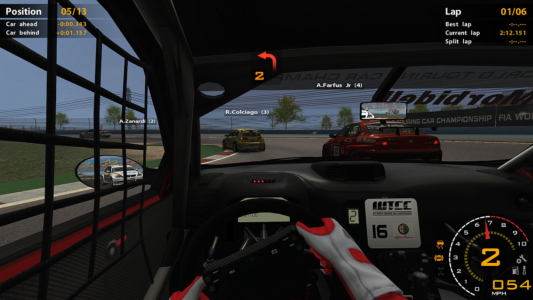
I never quite managed to cultivate a rivalry with/hatred of a fellow driver, unless calling Albert Farfus Jr ‘Foo-foo’ counts.
Having said that, the season provided plenty of surprises and challenges, with enough thrills and spills to keep things interesting. Despite the sterile, perfunctory presentation – and RACE is pretty unexciting visually, although I personally quite admired the slightly clinical graphics – the fact is that a season here provided more twists and turns, and more effective ‘stories’, than the scripted adventures of Ryan McKane et al in Race Driver. The drama in sport comes naturally: it doesn’t need anything else to help it along.
The other drivers do seem to genuinely race with you, displaying neither drone-like autonomy or suicidal aggression. (They do have a slightly amusing habit of flashing their headlights at you, in the manner of a Range Rover bombing down the outside lane of a motorway trying to get you to move over, when you’re trying to hold one of them off). There are a few nudges and accidents, but any thoughts of employing bumper-car tactics would be ill-advised – sometimes, they may come off, but there’s as much chance of bad consequences for you, which makes it a risk not worth taking. The damage modelling isn’t the most sophisticated, and even with the full race rules on, penalties don’t always seem to be enforced, which wasn’t a huge problem for me but may count as a black mark among racing aficionados.
The bulk of the 10 circuits are fairly standard, remaining in your mind long enough for you to complete a race weekend but rarely beyond that, unless you happen to commit to extended periods of pleasure/practice driving on any one of them. The final one, Macau, is most memorable, mainly because it’s rock hard – narrow, winding roads, with walls a-plenty and opportunities for overtaking limited. It has a feel of the Monaco GP about it, with a real danger element, and I never quite managed to master it.
Despite being generally successful in my time with RACE, these moments of failure really brought home to me what’s required to be a successful real-life racer. Do you, essentially, have the balls to drive aggressively, brake late and attack the corners, the skill to do so, and the levels of concentration required to repeat it, lap after lap? And for me, the answer, even on a simulation with driving aids and a significantly shortened race time, was no. Every time I tried, on those tracks where the AI had a full 2-3 seconds on me in qualifying, to really ‘go for it’, I just ended up in the gravel.
But there is enough flexibility in the settings to give you the feeling that you are a proper racing driver. Even if I couldn’t really hammer the lap times, on my chosen settings, getting round consistently without any mistakes was enough to achieve some success. And even that was challenging enough: pathetic as it sounds, I genuinely found the levels of concentration required rather exhausting. Even though the AI cars are quite easy to pass at the beginning of the race, achieving a decent position after a couple of laps was no comfort, as I knew that if I didn’t continue to lap well, they’d catch up and put me under pressure (and I’d probably crash, as anyone who’s played me at Gran Turismo would know).
I’m possibly not qualified to talk about the credentials of RACE as a simulation to satisfy the hardcore sim fan, and I’m sure my opinion here is coloured slightly by the fact that it provided exactly what I was looking for (basically, a more realistic updated TOCA, but better). Simbin produced a number of other more highly-acclaimed racers, including a follow-up to RACE (RACE 07, which boasts a number of expansion packs and mods, and which I’d like to try sometime) that may all be a better bet. But I did enjoy this one immensely, and I’d recommend it to anyone wanting to dip their top into the world of more serious racing sims.

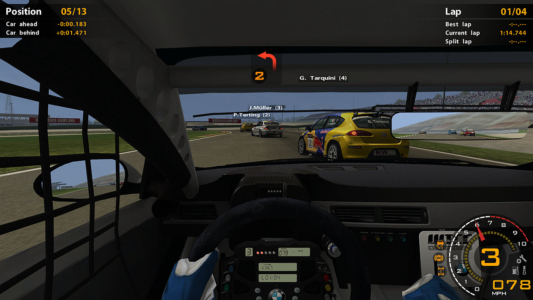
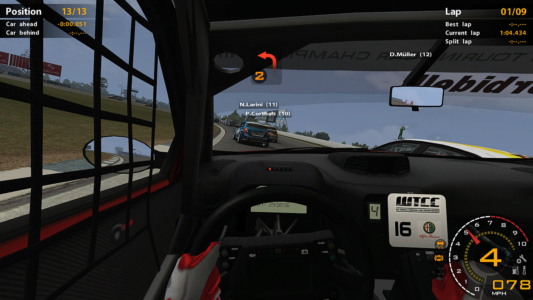
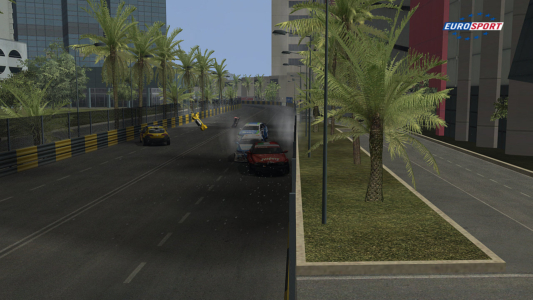
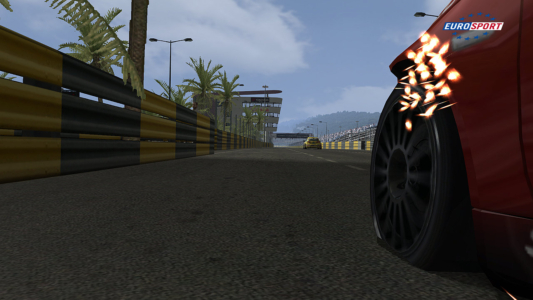

 Posts
Posts